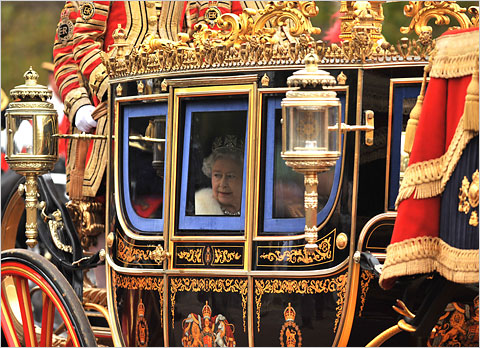Sovereign Grant

Yesterday morning with very little advance notice, the Chancellor, George Osborne, tabled the Sovereign Grant Bill in the UK Parliament (all papers on Treasury website – [broken link Oct 2024]). The bill provides for a new method of financing the Monarchy and replaces the existing somewhat complicated funding (which comprises 3 separate budgets – travel from Dept of Transport, Royal Palaces in England from DCMS and Civil List from the Treasury – background note here) with a single Sovereign Grant. This was first trailed in the Chancellor’s Autumn Spending Review [broken link October 2024] in October 2010 when it was announced that this would be “linked to the revenue of the Crown Estate” [broken link October 2024](para 2.143). The new Bill achieves this by setting out a formula for calculating the new Grant in Section 6 which will be based upon 15% of the net revenue surplus of the Crown Estate.
Whilst the bill provides greater clarity, simplicity and flexibility to the funding of the Monarchy (as well as proposing some modernisation of arrangements for the Duchy of Cornwall, for renewing the arrangement at the beginning each reign etc.), it does rather muddy the waters in relation to the Crown Estate. This has implications for the debate over devolution of the administration and revenues of the Crown Estate in Scotland.
First of all, it should be made clear that the revenues of the Crown Estate in Scotland and in England are public revenues. They derive from the time when the Monarch had significant real political power and funded HM armed forces HM ambassadors etc. Now that all such functions are funded by general taxation, the Crown revenues contribute to the general financing of the costs of Government either through the UK Treasury (to whom the Crown Estate revenues are paid) or directly to the Scottish Consolidated Fund for Crown revenues that are collected directly in Scotland by the King’s and Lord Treasurer’s Remembrancer. (This otherwise useful UK Commons Library Note [broken link Oct 2024] is incorrect when it states in Section 3 and Table 10 that Crown revenues from Ultimus Haeres in Scotland are paid to the UK Treasury).
There remains a need, however, to finance the Monarchy for the constitutional functions it performs and it is appropriate that this should be provided by the public purse. What is troubling, confusing and downright meddlesome about the whole affair is the link that has now been established between the Crown Estate and the Monarch. George Osborne stated in his speech [broken link Oct 2024] yesterday that,
“We need a funding mechanism that prevents the Sovereign from coming to Parliament each year for resources and provides funding broadly in line with growth in the economy.
There is such a mechanism at hand, through the historic connection with the Crown Estate.
From 2013-14, I am proposing that the Royal Household receive 15% of the profits made by the Crown Estate two years prior.“
Importantly, however, this is merely a formulaic link. The Crown Estate revenues will still be paid directly the the Treasury and there will be no hypothecation to the Royal Household (as indeed is made clear in Her Majesty’s gracious message to the House of Commons). The formula might just as easily be tied to the profits of the Stilton Cheese industry. The link is illusory, misleading and designed to re-establish a relationship that is purely historic. It is worth noting that this plan was not dreamt up by the Treasury on its own and has the fingerprints of a certain senior Royal all over it. It also provides a clever way of frustrating the ambitions of the Scottish Government to devolve the administration and revenues of the Crown Estate.
The Scottish Government paper, published last week, makes a worthy appeal for this to happen but provides little detail on the financial, political and constitutional case or on how the argument is intended to be made in Westminster. It fails to point out, for example, that devolving the administration and revenues of the Crown Estate in Scotland will actually save the UK Treasury money and it has very little to say about anything other than offshore renewables. (What about ports and harbours and what about the tenant farmer right to buy on Crown Estate agricultural estates for example?)
The other important element of Osborne’s speech is the 8th last sentence,
“We will shortly be setting out proposals, unconnected to this legislation, to make sure coastal communities can benefit from the development of the Crown Estate marine activities.”
One of the key arguments the Scottish Government has made is that with devolution, communities can benefit from the Crown Estate revenues from renewables. Indeed it published a consultation paper on this topic in November 2010. Now, along comes the Chancellor and announces just such a fund (which has got nothing whatsoever to do with the Bill), links the Crown Estate to the Royal Family and the job of the Scottish Government has just got that little bit harder – and all of this will be debated and announced in two weeks time at 2nd Reading in Westminster when the Scottish Parliament is in recess.
Scotland is different. The Scottish Crown revenues were not signed over in 1760. The Crown’s ownership of the seabed in fact has no statutory basis. Scotland already collects a significant amount of the Crown revenues for the Scottish Consolidated Fund through QLTR. The support that DCMS provides for palaces is for English palaces. The Scottish Parliament has the powers to legislate on the property rights of the Crown in Scotland. In other words, we need to remove the CEC from any role in Scotland because its role is not only archaic but because the Sovereign Grant Bill, by making a spurious link to the Crown Estate, risks complicating matters still further for the reform of the Crown Estate in Scotland.
Michty!
One thought on “Sovereign Grant”